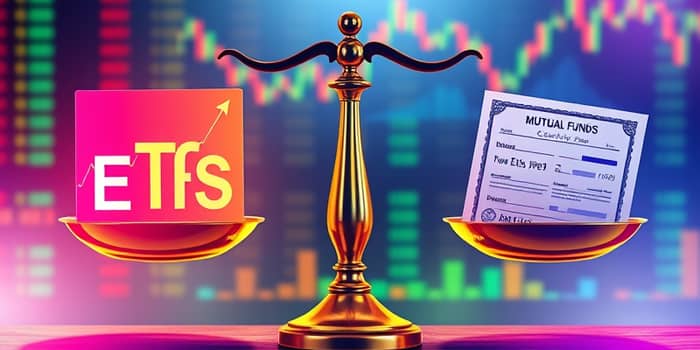
Investing can feel complex, but understanding the core distinctions between exchange-traded funds (ETFs) and mutual funds simplifies your path to financial growth. Both vehicles offer diversification and professional oversight, yet they operate under different rules, costs, and trading mechanisms. In this comprehensive guide, we’ll explore their definitions, similarities, key differences, use cases, and decision factors so you can choose the one that best aligns with your goals and preferences.
Mutual funds pool money from a broad base of investors to purchase a diversified portfolio of stocks, bonds, or other securities. These funds are professionally managed, with units priced at net asset value once daily after the market closes. Investors place buy or sell orders through the fund company or a broker, but all transactions settle at the same end-of-day price, ensuring simplicity and transparency.
By contrast, ETFs share a similar diversification model but trade on stock exchanges like individual equities. Their share prices fluctuate throughout the trading session based on real-time supply and demand. Investors can execute orders using various order types—market, limit, or stop—granting intraday trading flexibility that mutual funds cannot match. This liquidity can be crucial for those seeking immediate market exposure or tactical portfolio adjustments.
Both ETFs and mutual funds deliver the two pillars of prudent investing: diversification and access to expert portfolio management. They eliminate the need to pick individual stocks or bonds, spreading risk across a wide array of holdings.
These features are particularly valuable for investors with limited time for research, as funds continuously monitor, rebalance, and adjust holdings to align with stated objectives. Whether you prefer a passive index strategy or an actively managed fund, both structures are designed to help achieve diversified market returns.
Despite their shared benefits, ETFs and mutual funds diverge significantly in how investors buy, sell, and price shares. These operational differences can impact cost, accessibility, and tax outcomes.
ETFs may incur bid-ask spreads, especially in niche sectors with lower trading volumes, while mutual funds avoid this market friction. However, mutual funds can generate capital gains distributions throughout the year, triggering tax events for all shareholders—not just those selling shares.
Costs and tax consequences directly influence net returns, making them vital factors in any investment decision. ETFs typically benefit from lower expense ratios thanks to their passive structures and streamlined trading mechanisms. Broad-based index ETFs commonly charge annual fees as low as 0.03% to 0.20%, whereas many actively managed mutual funds charge between 0.40% and 1.00%, sometimes plus sales loads or redemption fees.
Tax efficiency is another major advantage for ETFs. Their unique creation and redemption in-kind process reduces taxable distributions, granting investors greater control over capital gains events. In contrast, mutual funds often distribute realized gains annually, resulting in unpredictable tax liabilities. For those in taxable accounts, superior tax efficiency of ETFs can translate into meaningful after-tax savings over the long term.
ETFs are especially appealing for investors who value cost-effectiveness, flexibility, and tax control. Consider ETFs if you:
Active traders and tactical investors leveraging market movements often favor ETFs for their responsive trading capabilities and lower cost barriers to entry.
Mutual funds maintain advantages in scenarios focused on automation, simplicity, and fixed-dollar investing. They may suit investors who:
Retirement accounts such as 401(k) or IRA plans frequently feature mutual funds, offering built-in convenience for retirement savings through payroll deductions and reinvestment options.
Choosing between ETFs and mutual funds requires a holistic view of your financial circumstances. Key factors include:
By aligning your preferences with these criteria, you can identify the vehicle that best supports your broader financial plan and personal investing style.
For many investors, a balanced approach that integrates both ETFs and mutual funds produces optimal results. For instance, you might anchor core holdings with low-cost index ETFs for broad market coverage while allocating smaller positions to actively managed mutual funds that target high-conviction sectors or strategies.
This hybrid model leverages the strengths of each vehicle—cost efficiency, flexibility, and tax advantages from ETFs, combined with specialized active management and automation from mutual funds. Regular portfolio reviews and rebalancing ensure your allocations remain aligned with evolving market conditions and personal goals.
To illustrate how different goals and preferences shape fund selection, let’s consider two hypothetical investors:
These profiles demonstrate that blending both vehicles addresses distinct objectives—yield-focused investors may lean toward mutual funds for consistent payouts, whereas growth-oriented individuals might prefer ETFs for their agility and cost efficiency.
Whether you select ETFs, mutual funds, or a combination of both, the right choice depends on your unique financial objectives, risk tolerance, and investment horizon. Understanding each vehicle’s trading mechanics, cost structure, and tax implications empowers you to make informed decisions that enhance your long-term wealth-building journey.
Remember that consistency, discipline, and a clear strategy often matter more than the specific vehicle you choose. Armed with these insights, you’re well-equipped to design a portfolio that supports your ambitions and adapts over time.
References













